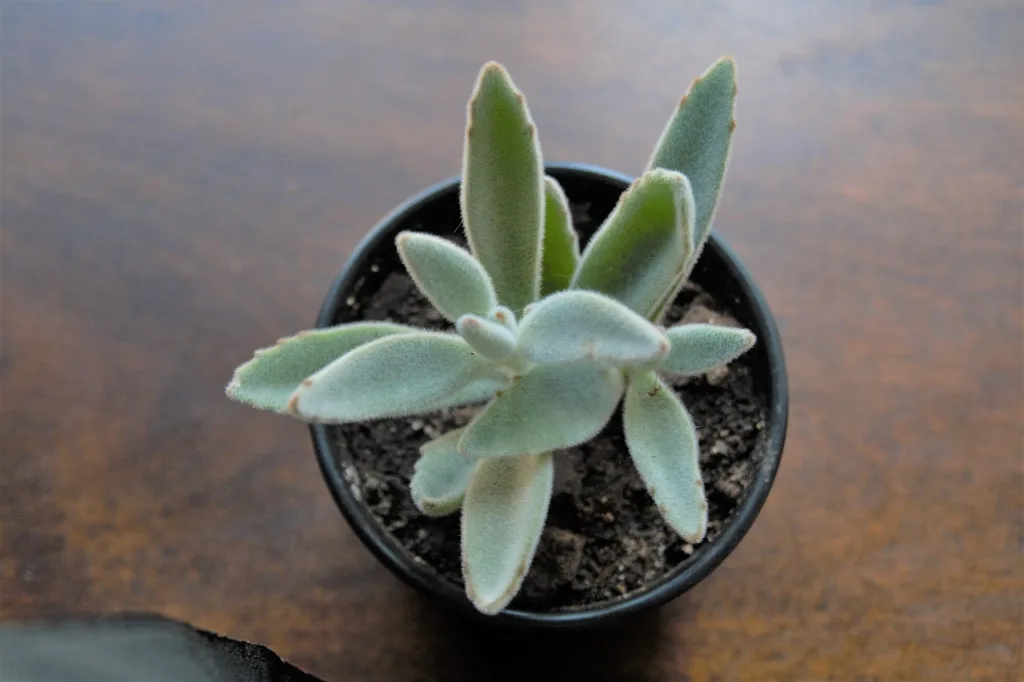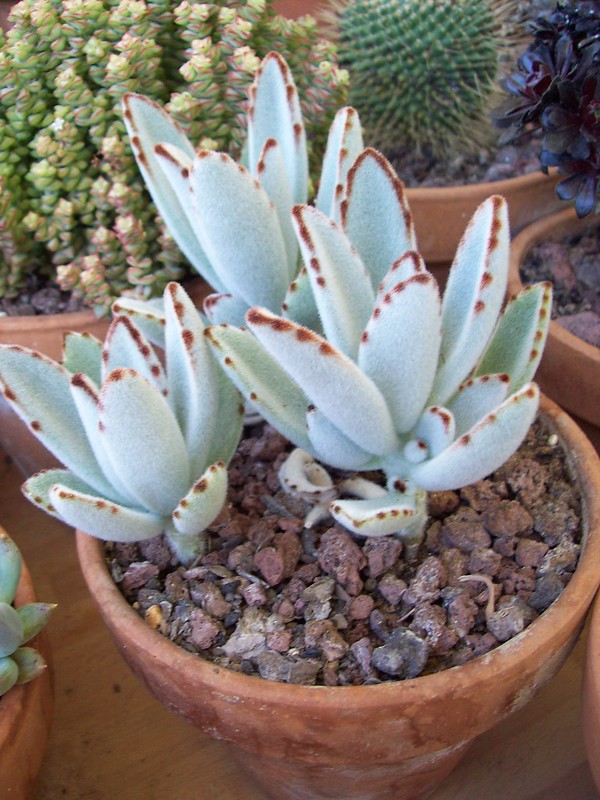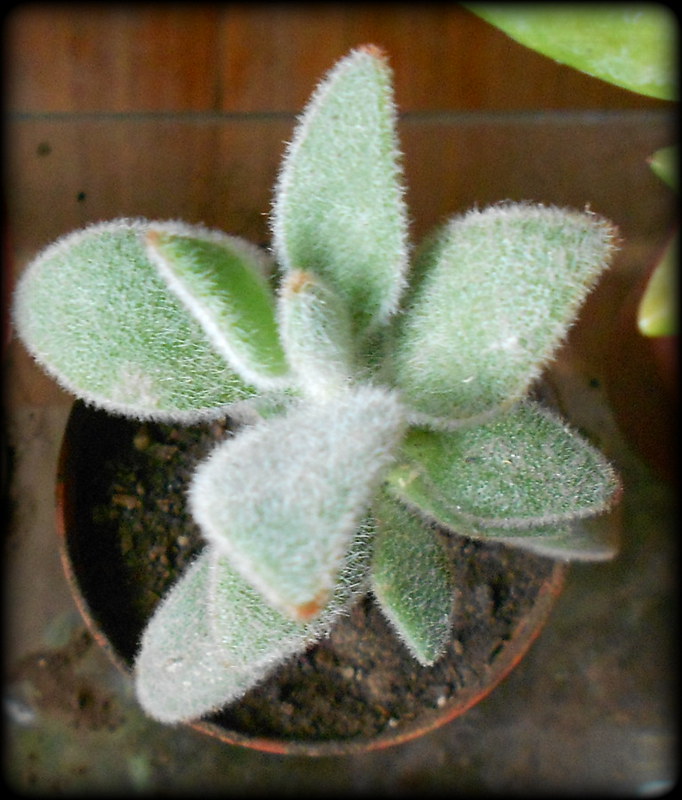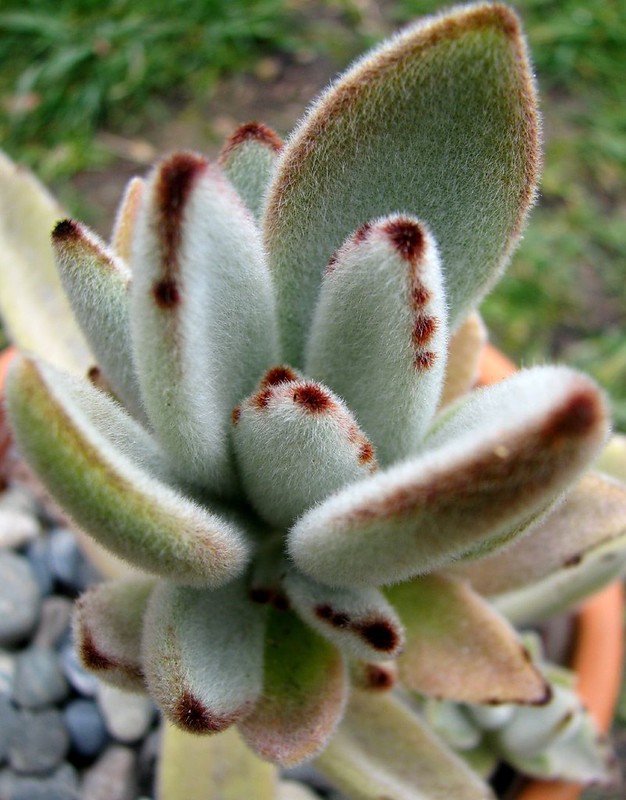Kalanchoe Tomentosa, commonly known as “Panda Plant,” “Pussy Ears” or “Chocolate Soldier,” is a succulent plant with a characteristic appearance and ease of care.
Native to Madagascar, this succulent belongs to the Crassulaceae family and has become a favorite among plant lovers due to its unique characteristics.
| Key Characteristics: Fuzzy Leaves: One of the rare features of Kalanchoe tomentosa is its dense covering of small, silvery-white hairs on the leaves. This “fuzzy” texture gives the plant its common name, Panda Plant resembling the fur of a panda. Leaf Shape: The leaves are oval or spoon-shaped, with a slight indentation at the tips. The edges may have a reddish tint, adding to the visual appeal. Leaf Coloration: The base color of the leaves is typically grayish-green, providing a neutral backdrop for the contrasting hairs. Under stress or in certain growing conditions, the tips of the leaves can take on a reddish hue. Compact Growth Habit: Kalanchoe tomentosa tends to have a compact and bushy growth habit, making it suitable for container gardening and indoor spaces. Flowering: In the right conditions, Panda Plants may produce small tubular flowers on tall stems. The flowers are often orange or yellow and can emerge in clusters. |
| Characteristic | Description |
|---|---|
| Scientific Name | Kalanchoe tomentosa |
| Common Names | Panda Plant, Chocolate Soldier, Cocoon Plant |
| Family | Crassulaceae |
| Native to | Madagascar |
| Plant Type | Succulent |
| Growth Habit | Compact, upright |
| Height | Up to 1-2 feet (30-60 cm) |
| Leaf Characteristics | Densely covered with tiny, soft, silvery-white hairs; rust-brown or maroon leaf edges |
| Flowering Season | Late winter to early spring |
| Flower Colors | Yellow to orange |
| Cultural Preferences | Well-draining soil, bright indirect light |
| Watering Needs | Infrequent watering; allow soil to dry between waterings |
| Propagation | Leaf or stem cuttings; allow cuttings to callus before planting |

Choosing the Right Environment
Before diving into the details of planting and caring for Kalanchoe tomentosa, it’s important to understand the environment in which this succulent blooms.
Native to Madagascar, these plants are accustomed to hot and dry conditions, making them an excellent choice for indoor farming.
Kalanchoe tomentosa prefers bright, indirect sunlight, making it ideal for areas close to windows or balconies.
It can tolerate a few hours of direct sunlight, but prolonged exposure may cause damage to the leaves. Additionally, this succulent enjoys warm temperatures ranging from 60°F (15°C) to 85°F (29°C).
Planting Kalanchoe Tomentosa
Now that you have a good understanding of the environment Kalanchoe Tomentosa thrives, let’s move on to planting this delightful succulent.
1. Choosing the Right Container
Select a container that has drainage holes to prevent waterlogging. Kalanchoe tomentosa doesn’t like sitting in soggy soil, as it can lead to root rot. A shallow container will suffice as these plants have a relatively shallow root system.
2. Preparing the Soil
Use a well-draining potting mix suitable for succulents and cacti. You can also create your own by mixing equal parts of potting soil, perlite, and sand. This mixture provides excellent drainage and prevents water retention.

3. Planting the Succulent
Gently remove the succulent from its nursery pot, being careful not to disturb the roots. Place it in the prepared container, ensuring it sits at the same depth as it was in its original pot. Fill the remaining space with the potting mix, gently pressing it down to provide stability.
4. Watering
After planting, water the succulent thoroughly, allowing the excess water to drain through the holes. Remember not to overwater, as this can lead to root rot.
Allow the soil to dry out between waterings, typically every 10 to 14 days. Adjust the watering frequency based on the temperature and humidity levels in your environment.
Growing and Caring for Kalanchoe Tomentosa
Once you’ve successfully planted Kalanchoe tomentosa, it’s time to focus on its growth and care. This plant requires minimal attention, making it suitable for both beginner and experienced gardeners.
1. Light Requirements
As mentioned earlier, Kalanchoe tomentosa thrives in bright, indirect sunlight. Place it near a south or west-facing window where it can receive adequate light throughout the day.
If you notice the leaves stretching or becoming leggy, it may indicate that the plant isn’t receiving enough light.
2. Temperature and Humidity
Maintaining the right temperature is crucial for the healthy growth of Kalanchoe tomentosa. Aim to keep the plant in an environment where the temperature stays within the range of 60°F (15°C) to 85°F (29°C). Avoid exposing it to temperatures below 50°F (10°C) as it may result in leaf damage.
Regarding humidity, this succulent is relatively adaptable and can tolerate average humidity levels. However, if you live in a particularly dry climate or during the winter months when indoor heating reduces humidity, consider using a humidifier or placing the plant on a tray filled with water and pebbles to increase humidity around it.

3. Kalanchoe Tomentosa Pruning and Propagation
Pruning Kalanchoe Tomentosa is not mandatory, but it can help maintain a compact and bushy shape. If you notice any leggy stems or damaged leaves, feel free to use clean, sharp scissors or pruning shears to remove them. You can also propagate the plant through stem or leaf cuttings.
To propagate through stem cuttings, carefully select a healthy stem, ensuring it has at least two sets of leaves.
Remove the bottom leaves, leaving a small portion of the stem exposed. Allow the cuttings to callus for a few days before placing them in a well-draining soil mix. Water sparingly and provide bright, indirect light until new growth appears.
4. Fertilizing
Kalanchoe tomentosa doesn’t require frequent fertilization. During the active growing season, which generally spans from spring to summer, you can feed the succulent with a balanced, water-soluble fertilizer diluted to half-strength. Apply the fertilizer once a month, following the package instructions.
5. Pests and Common Issues
One of the reasons Kalanchoe tomentosa is adored by many gardeners is its resistance to pests and diseases. However, like any plant, it can still encounter a few issues. Here are a couple of common problems and their remedies:
Mealybugs: If you spot white, cotton-like masses on the leaves or stems, it’s likely a sign of mealybug infestation. To treat the problem, remove the pests manually using a cotton swab dipped in rubbing alcohol. Repeat the process until the infestation is under control.
Root Rot: Overwatering or poorly draining soil can lead to root rot in Kalanchoe tomentosa. If you notice the plant’s leaves turning yellow, mushy, or wilting, it’s an indication of root rot. To salvage the succulent, remove it from the container, trim away the affected roots, and replant it in fresh, well-draining soil.
Conclusion
Congratulations! You now have all the knowledge and skills needed to plant, grow, and care for Kalanchoe tomentosa.
Remember to provide it with the right amount of light, temperature, and water, and you’ll be rewarded with a beautiful and resilient succulent for years to come. The adorable appearance of this remarkable plant adds a touch of nature to your living space.
So go ahead, get your hands dirty, and embark on this rewarding journey of cultivating Kalanchoe tomentosa. Happy gardening!

FAQs
Does Kalanchoe tomentosa need full sun?
- Kalanchoe tomentosa, or Panda Plant, prefers bright, indirect light. While it can tolerate some direct sunlight, it generally thrives in partial sun conditions and can also adapt to indoor settings.
How do you take care of a panda plant?
- To care for a Panda Plant, provide well-draining soil, water sparingly, and allow the soil to dry between waterings. Place it in a location with bright, indirect light, and protect it from extreme temperatures. Regularly inspect for pests and provide occasional fertilization during the growing season.
What are the benefits of Kalanchoe tomentosa?
- Kalanchoe tomentosa is appreciated for its unique appearance, ease of care, and air-purifying properties. Like many succulents, it can enhance indoor and outdoor spaces with its distinctive foliage.
Why is it called a panda plant?
- The name “Panda Plant” is derived from the plant’s appearance. The leaves, covered in silvery-white hairs with rust-brown edges, resemble the furry coat of a panda.
Kalanchoe tomentosa flower?
- Kalanchoe tomentosa may produce small tubular flowers in clusters during late winter to early spring. The flower colors can range from yellow to orange, adding a delightful touch to the plant.

